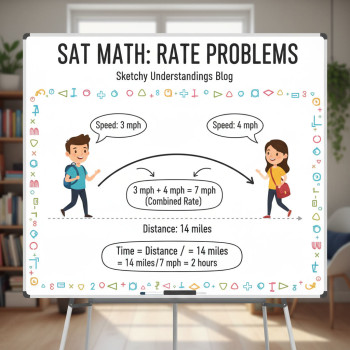Why a Missing Detail Can Cost You Big on the Digital SAT
Imagine you’re one question away from a practice-test personal best. You read a sentence, choose an answer that matches your first impression, and move on. Later, when you review, you realize you misread a single word—”most” instead of “some”—and that flip changed everything. That tiny oversight cost you points, confidence, and time. On the Digital SAT, where precision meets speed, attention to detail is not a nicety; it’s a superpower.
Understanding how the Digital SAT is structured—and how your mistakes usually happen—is the first step toward being the kind of test taker who notices the quiet signals in questions and avoids avoidable errors. The College Board provides official descriptions and practice resources for the Digital SAT that help you set a target score and use tailored practice; combining those resources with focused attention training is a winning approach. ([bigfuture.collegeboard.org]( “Attention to Detail” Really Means for SAT Questions
Attention to detail on the SAT means more than careful reading. It’s a cluster of habits and skills that include:
- Close reading: noticing qualifiers (only, most, some, except), time frames, and who is doing what in a sentence.
- Precision in math: tracking units, signs, and small algebraic manipulations without dropping negative signs or decimal places.
- Answer verification: checking that your answer responds to exactly what was asked, not what you wish had been asked.
- Format awareness: reading instructions carefully—especially on the Digital SAT where tools and response formats can differ from paper tests.
When these pieces fit together, you convert good instincts into reliable scores.
Real-world examples: how small details become big problems
Here are two typical scenarios students see in practice tests:
- Reading: A passage-based question asks which choice “best supports the author’s claim about X.” You pick the most relevant sentence—but it only supports the claim indirectly. The correct choice explicitly links cause and effect. You missed the specific phrase that signals direct support.
- Math: An algebra problem asks for the value of 2x when x satisfies an equation. You solve for x but forget to multiply your final value by 2. One step missed, and you drop points.
Both are solvable with the same habit: pause, parse, and confirm. The Digital SAT’s interface, official practice tools, and detailed score reports (available in students’ accounts) can help you identify the frequent kinds of detail-driven mistakes you make. ([bigfuture.collegeboard.org]( the Digital Format Makes Detail Work Both Easier and Harder
The move to a fully digital SAT changes some mechanics—shorter test length overall and different on-screen tools—which can influence how you notice detail. Digital delivery offers benefits like easier navigation between questions and built-in tools for highlighting or marking, but it also brings new pitfalls: screen fatigue, scrolling traps, and occasional misclicks.
College Board’s guidance on the Digital SAT explains device setup and test-day mechanics, and their practice resources emphasize targeted preparation. Use those official instructions to simulate realistic conditions and avoid technical slip-ups that look like attention errors. ([satsuite.collegeboard.org]( tip
Practice under the exact conditions you’ll test in: same device orientation, brightness similar to test-day settings, and use the digital tools during practice so they become second nature. Developing a short pre-question checklist—read prompt, underline target words, note required units—turns attention into routine.
How to Train Attention to Detail: Daily Routines That Work
Attention is a muscle. You build it through regular, targeted practice. Here are concrete routines students can adopt—each with a simple example you can try today.
1) Micro-reading drills (15 minutes)
Pick a paragraph from a practice passage. In 10 minutes, annotate every qualifier and every phrase that defines cause/effect or contrast. Then answer two detail-oriented questions and check whether your annotations predicted the correct answers.
2) The two-pass math method
Pass one: read the problem fully, identify what’s asked, and estimate a rough answer or range. Pass two: solve carefully, writing intermediate steps clearly, then compare the exact result to your estimate. If the estimate and solution disagree wildly, stop and re-evaluate an earlier step.
3) Reverse engineering wrong answers
When you miss a question, don’t just read the explanation—figure out how the wrong answer could have seemed right. Often, distractors trick students by changing one keyword or by reversing a relationship. Catalog these patterns in a short log. Over time you’ll recognize your own traps.
4) Timed focus sprints
Set a timer for 12 minutes and do 6–8 short, detail-focused questions (mixed reading and math). Track accuracy and specific error types—misread word, arithmetic slip, misapplied rule. A few weeks of sprints moves precision from conscious effort to habit.
Sample Weekly Plan to Strengthen Detail Skills
Below is a simple, sustainable week that balances practice, review, and reflection. Repeat and adjust based on your score report trends.
| Day | Activity | Focus | Time |
|---|---|---|---|
| Monday | Read 2 passages + 8 questions | Qualifier spotting, inference vs. support | 50 min |
| Tuesday | Math problem set (algebra & data) | Units, signs, intermediate checks | 50 min |
| Wednesday | Timed focus sprints | Speed + accuracy balance | 30 min |
| Thursday | Review mistakes + log | Pattern identification | 40 min |
| Friday | Full section simulation (digital) | Test-day stamina, tools | 70 min |
| Saturday | Practice test (or Khan Academy practice set) | Full practice + reflection | 2–3 hrs |
| Sunday | Light review, plan next week | Rest + strategy | 30 min |
How to Diagnose the Kind of Detail Errors You Make
Not all attention mistakes are the same. Accurate diagnosis helps you fix the root cause instead of just treating symptoms.
- Skimming errors: You read too fast and miss negations or qualifiers. Fix: slow down at the question stem and use underlining.
- Calculation mistakes: Math arithmetic slips, sign errors, or decimal mishandling. Fix: write all steps, estimate, and double-check units.
- Interpretation errors: You infer beyond the passage or ignore what is explicitly stated. Fix: circle “direct support” or “inference” words and ask: “Does the passage say this?”
- Interface errors (Digital SAT-specific): Misclicks, skipping an on-screen tool step, or mis-formatting an answer. Fix: simulate test conditions and practice the toolset until muscle memory kicks in. ([satsuite.collegeboard.org]( to Use on Test Day (Short, Reliable, Repeatable)
When you sit down for the Digital SAT, your attention plan should be simple—because complexity collapses under pressure. Here are five things to do before you answer:
- Read the question stem first. Know exactly what’s asked before you read the passage or solve the equation.
- Underline or mentally tag qualifiers: only, all, most, sometimes, except, always.
- For math, write the units, and note if the answer must be positive, integer, or a fraction.
- Pause before moving on: spend 3–5 seconds verifying your answer against the stem.
- If unsure, mark for review—but don’t rush; sometimes re-reading the stem reveals the subtle clue you missed earlier.
Quick checklist you can memorize
Stem → Key words → Estimate → Solve → Verify
How Personalized Tutoring Accelerates Detail Mastery
Many students find that group classes give broad strategies, but 1-on-1 tutoring is where attention work becomes surgical. Personalized tutors can:
- Create tailored practice plans that target your unique error patterns.
- Provide real-time feedback on your annotation habits and problem-solving steps.
- Use AI-driven insights to track error trends and adjust practice focus week to week.
Sparkl’s personalized tutoring provides these kinds of benefits—1-on-1 guidance, tailored study plans, expert tutors, and AI-driven insights—which help convert small, repeatable habits into lasting precision. When detail work is practiced with a coach who understands your patterns, progress happens faster and with less wasted effort.
Examples: Before and After Attention Training
Seeing a concrete example helps. Below are two short case studies that show typical student journeys.
Case Study A: The Skimmer
Before: Amelia skimmed passages, focusing on general meaning. She got many inference questions wrong because she missed qualifiers.
After: Her tutor taught a two-pass reading method: skim for structure, then read the question stem and return to the passage to underline supporting language. Her reading-section accuracy rose by 12 percentage points in four weeks.
Case Study B: The Calculator Reliant
Before: Malik used a calculator for every arithmetic step and often mis-copied intermediate results. This led to arithmetic errors in multi-step problems.
After: His practice emphasized mental estimation and checkpoint checks (compare to an estimate after each major step). He cut calculation errors by half and improved confidence under time pressure.
Common Question Types That Demand Extra Attention
Certain question families are especially vulnerable to detail errors. Familiarize yourself with these and practice them deliberately.
- Comparative reading questions: require exact alignment between passage claims and answer choices.
- Function and transformation math items: small algebraic sign or distributive mistakes can invalidate a whole solution.
- Data interpretation: charts and tables often contain units, baselines, or truncated axes that change the conclusion.
- Command of evidence or evidence-based multiple choice: these require a two-step process—answer and then pick evidence—which invites mismatches unless you verify each step.
How to Use Official Resources Efficiently
The College Board and BigFuture describe how to set target scores, access official practice, and view score reports. Use official practice tests to simulate the exact question styles and interface behavior you’ll face—these are the best diagnostic tools for detail errors because they mirror real test mechanics. ([satsuite.collegeboard.org]( your score reports not as a single-number judgment but as a map: which question types and subscores show recurring detail misses? Once you know that, you can design micro-practices that address the exact weakness.
Tools and Techniques to Reduce Human Error in Math
Math mistakes are often mechanical. You can reduce them with simple habits:
- Write intermediate results and box final answers.
- Carry units through every step (e.g., “miles/hr”) and check that final units make sense.
- Use estimation: before committing, ask, “Is this roughly the size I expected?”
- Use the digital calculator effectively: know when it helps and when it hides arithmetic errors.
Measuring Progress: What Improvement Looks Like
Attention training is gradual. Expect stepwise improvements and periodic plateaus. Track progress by:
- Logging error types and frequency weekly.
- Comparing accuracy on targeted question types across practice tests.
- Noting time-per-question changes—precision shouldn’t always mean slowness; efficiency improves with practice.
Official practice and diagnostic reports show which areas improved, but the real signal is fewer avoidable mistakes and stronger confidence when you hit confusing language or multi-step math.
Final Thoughts: Treat Details Like Signals, Not Noise
In the context of the Digital SAT, detail isn’t minutiae to be skimmed over; it’s the language of the test. Questions are intentionally precise, and they reward careful readers and thinkers. By practicing targeted routines, simulating the digital environment, and—if possible—working with a tutor for personalized feedback (for example, Sparkl’s 1-on-1 tutoring that tailors study plans and uses AI-driven insights), you turn attention to detail from a frustration into a dependable advantage.
Photo Idea : A focused student at a laptop with the Digital SAT interface visible, underlining a passage on-screen and taking notes in a notebook; warm natural light, calm environment. Quick Starter Checklist You Can Use Today
- Before practice: set one micro-goal (e.g., “no qualifier misses on reading today”).
- During practice: use the two-pass math method and the stem-first reading method.
- After practice: log every mistake and label it (skimming, calc, inference, interface).
- Weekly: review your log and update your study plan to focus on the top two recurring errors.
One final encouragement
Attention to detail might feel like a personality trait—something you either have or you don’t—but it’s really a set of learnable behaviors. With consistency, the habits you create now will pay off not only on the Digital SAT but in college work and beyond. Start small, practice intentionally, and let accuracy compound into confidence.
Photo Idea : A tutor and student in a one-on-one session reviewing a digital SAT question together on a tablet, pointing to a highlighted phrase and smiling as the student has an “aha” moment. Good luck—read closely, check often, and remember: the difference between a good score and a great score is often just one well-noticed detail.
















No Comments
Leave a comment Cancel